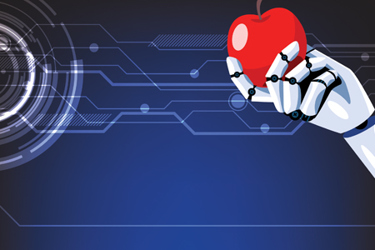AI In Water Management: Plucking The Low-Hanging Fruit
By Joe Halliday

Tips for bringing the promise of digitalization and AI within reach of water utilities.
The water sector stands on the brink of a technological revolution. Society at large has already embraced automation of manufacturing, self-driving cars are on the streets, and both healthcare professionals and commercial airline pilots are significantly guided by intelligent, digital technology to make better, faster, and safer decisions. Water and wastewater management is poised for a future where intelligent systems optimize operations beyond what we as humans can do alone. This transformation is partly driven by a new generation of variable speed drives that are no longer just simple motor shaft turners controlling the speed of a pump or mixer, but valuable sensors and AI-powered processors.
The Digitalization Dilemma: Overcoming The Barriers To Entry
Despite the promise of digitalization, water utilities face significant challenges. The water industry is characterized by a wide spectrum of digital maturity. Some utilities operate with minimal digital infrastructure, while others boast sophisticated, sensor-driven systems. Irrespective of the current maturity level, most utilities realize that the future is smarter and more digital. Budget constraints often limit investments in new technologies, and the initial costs of sensors and systems can seem prohibitive. There is a clear need to be able to do more with less, instead of adding costs and complexity. Moreover, the critical nature of water infrastructure demands robust cybersecurity measures, adding another layer of complexity and cost.
The AI Revolution: Drives As The Unsung Heroes Of Digitalization
A new breed of smart drives is emerging as a game-changer in this landscape. Conventional drive wisdom will tell you that, by the law of affinity in physics, you can save 40% of the energy used on variable-load applications by equipping direct on-line (DOL) motors with variable speed drives. Smart drives go beyond simply controlling motor speed to save energy on variable loads; they act as advanced sensors, continuously monitoring parameters like current, temperature, and vibration. More importantly, they possess built-in AI and machine learning (ML) capabilities, allowing them to analyze and correlate data in real time, detect patterns, identify anomalies, and predict potential issues before they escalate into costly downtime. Water and wastewater systems are immensely complex, and many of the challenges operators face are not visible to the human eye or comprehensible to us.
Like surgeons and pilots, operators and managers could benefit immensely from digital, data-driven decision support.
Unlocking Efficiencies With AI-Powered Drives
The new generation of smart drives offers a plug-and-play approach to AI, delivering immediate benefits across the water sector:
- Predictive maintenance: Imagine a drive that can detect a slight increase in motor vibration, indicative of bearing wear, weeks before a potential failure. This early warning allows for proactive maintenance, minimizing downtime, reducing costs, and preventing environmental incidents.
- Operational optimization: AI-powered drives can analyze operational data to uncover hidden inefficiencies. For example, by analyzing pump performance curves, the drive can identify optimal operating points and detect anomalies before they are visible to the human eye, reducing energy consumption and extending equipment lifespans.
- Real-time control: These smart drives can dynamically control motors in real time based on changing conditions and operating patterns. In a wastewater treatment plant or collection system pump station, this could mean automatically detecting clogging pumps and running a de-ragging function to avoid expensive maintenance and increase pump and system efficiency in real time.
Cybersecurity In The Age Of Smart Drives
As water systems become increasingly interconnected, cybersecurity is paramount. Intelligent drive manufacturers are acutely aware of these risks and incorporate robust security features into their products. These include secure communication protocols, data encryption, and tamper-proof designs. By choosing drives with built-in security features, utilities can strengthen their overall cybersecurity posture. Some smart drives offer built-in edge computing, allowing utilities to harvest the power of advanced machine learning and data processing without relying on external computing power and cloud systems.
Collaboration: Driving Innovation In The Water Sector
The transition to a smarter water future requires collaboration. Drive manufacturers are partnering with utilities to develop tailored solutions and provide ongoing support. Knowledge-sharing platforms and industry forums are crucial for disseminating best practices and fostering innovation. The smart drives are ready off the shelf today, but further work in real-life systems and settings is required to fully capture their potential. As examples, advanced pattern recognition of pressure transients, as well as early and reliable cavitation detection and control in water and wastewater systems, require more demonstration and learning in real-life systems outside manufacturers’ labs.
In a nutshell, the technology has matured but applications need further work and will have to rely on a collaborative approach to innovation.
Embracing An Intelligent Water Future
The water sector is on the cusp of a paradigm shift. Smart drives are not just a technological advancement; they are the building blocks of a self-driving, human-in-the-loop AI future in water. By leveraging drives as sensors and intelligent controllers, instead of mere motor shaft turners, water utilities can overcome initial digitalization hurdles and reap immediate benefits. Effects not only include drastic reduction of breakdowns, improved operational efficiency, and improved cybersecurity but also pave the way for more ambitious digital transformation initiatives in the future. The key is to start small, focus on achievable goals, and leverage the low-hanging fruits of AI to cultivate a smarter, more sustainable water future.
About The Author
 Joe Halliday is the director of sales, U.S. water market for Danfoss Drives. He joined the Danfoss water team in October 2010. Prior to that Joe was the sales director for Sierra Instruments, a thermal mass flow meter company in Monterey, CA. Joe has been working in the industrial automation industry for more than 25 years. He is a graduate of the University of Rochester and spent nine years as a naval aviator flying helicopters for the U.S. Navy in the Mediterranean and Persian Gulf, where he became a veteran of Desert Storm.
Joe Halliday is the director of sales, U.S. water market for Danfoss Drives. He joined the Danfoss water team in October 2010. Prior to that Joe was the sales director for Sierra Instruments, a thermal mass flow meter company in Monterey, CA. Joe has been working in the industrial automation industry for more than 25 years. He is a graduate of the University of Rochester and spent nine years as a naval aviator flying helicopters for the U.S. Navy in the Mediterranean and Persian Gulf, where he became a veteran of Desert Storm.
